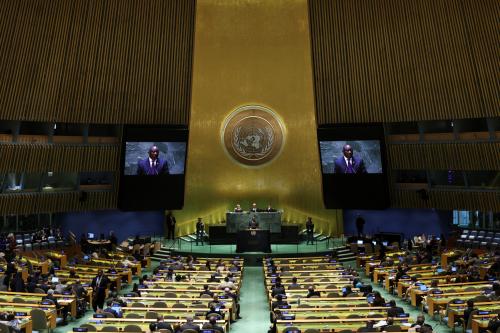Imagine yourself as a local villager, part of a community group in an African town outside a major city. You wake up one morning after a storm to a river of construction materials across your land from the road being constructed nearby. You know that it is a national government project and that there is financing from the African Development Bank (AfDB) and the World Bank and possibly from some U. S. agency. There had been many consultation meetings prior to the construction and the community group was aware of the appraisal reports and environmental reports and resettlement plans. But once the work began, there were no discussions or information on what was happening. The construction began and then suddenly stopped several weeks before. Your community group is unable to identify a government official for help so they go on the internet and find the project on the AfDB and World Bank websites. But the AfDB has posted no reports on the progress of the project under implementation. On the World Bank website you can see that the Bank has an implementation report but it only shows that the project was downgraded as a high risk without any explanation as to why or what this meant. The name of the contractor is available but not the contract nor any possible amendments to the contract. The group checks on the website of USAID and finds it difficult to navigate and find anything related to the project. They then try the Millennium Challenge Corporation (MCC) website and find extensive details on the country compact but not on the specific investment.
What is striking about this situation is the asymmetry of information disclosed before the project begins compared with during its implementation. What is even more striking is that the highest rated donor agencies in the Aid Transparency Index don’t consistently provide this information. With adequate information the group could advise the government and the Banks on how to adapt the project to avoid a growing problem that may not be captured until the post-evaluation report. This is the underlying concern that is documented in the recently published “Accessibility and effectiveness of donor disclosure policies when disclosure clouds transparency,” which I prepared along with co-author Claire Horton for the annual Advancing Good Governance in International Development conference held at Oxford.
For all the progress of Freedom of Information laws across donor countries and the substantive disclosure reforms of the Access to Information policies of the international finance institutions (IFIs), there remains a critical blind spot that jeopardizes the potential impact of transparency. Moreover, where there is disclosure, the accessibility of that information is questionable at best, even by people who know the institutions and their particular institutional jargon. And the initiatives and agencies that have been crucial in mobilizing worldwide attention to donor disclosure, the International Aid Transparency Initiative (IATI) and the Aid Transparency Index (ATI) of Publish What You Fund have not sufficiently focused on this key information gap.
To explore the policies and practices, my co-author and I trawled the websites of specific agencies to assess the type of information and its accessibility during project implementation. The selected agencies were those that provide aid to governments and that fund substantial investment projects with multiyear implementation. The institutions reviewed were four of the IFIs (the World Bank, AfDB, Asian Development Bank, and Inter-American Development Bank). In addition we reviewed a number of bilateral donors to understand the broader applicability, including the U.K.’s Department for International Development, USAID, and the MCC. The report’s findings can be summarized by the following three points.
- Accessible information during the implementation of donor projects is crucial in being able to adapt to changing circumstances and monitoring negative effects. Donor aid is working in difficult and changing environments in which the donors don’t have sufficient capacity to monitor progress adequately. Engaging civil society, which has already been considered essential during preparation and design, is equally important, if not more so, during implementation. Have the anti-malarial bed nets been adequately treated? Were the textbooks delivered as planned to the targeted schools? Was the road built according to design? These are all issues that can only be caught during implementation. Waiting for post-evaluation is too late. There are numerous examples of the impact of engaging civil society during project implementation, including good practice efforts through community development projects (CDD); all such efforts require timely and accessible information.
- Donor reform efforts have largely ignored the disclosure and accessibility of information during implementation. The IFIs adopted major reforms to their disclosure policies following the World Bank’s lead in 2010. The most significant change was to move from a positive list of what the IFIs will disclose with all else being confidential to a negative list of what the IFIs won’t disclose with all else being open to the public. One of the major changes was that project implementation reports, the reports by IFI task managers on project progress updated twice a year, would be disclosed. The release of implementation reports, however, generated an intense debate within the IFIs as there were understandable concerns that disclosure would affect the candor of reporting by task managers. There needed to be some confidentiality so that they could report concerns such as corruption or personnel issues to management. This contributed to the agreement not to disclose “deliberative” information in order to protect dialogue within the institution. For implementation reports, this led to sections of the report being maintained as confidential. Unfortunately, it does appear, to those of us who worked on the policy, that the principle of “deliberative” material has been applied more broadly than originally intended. Despite the fact that seven of the eight agencies reviewed scored among the top 10 in Publish What You Fund’s Aid Transparency Index (ATI), the bottom line is that there is no consistent, systematic, institutionalized focus on providing sufficient information that would facilitate stakeholder engagement during project implementation. Even when the information is disclosed, the search process requires substantial effort and significant technical knowledge to be able to investigate. Underpinning all of this is the fact that disclosed documents are not looked at in terms of their use by external sources.
- IATI and Publish What You Fund’s ATI could play a key role in moving the agenda. The establishment of the IATI standard for publishing aid information and the commitment of development agencies in 2011 at the Busan High-Level Forum to meet this standard by 2015 have provided a targeted rallying point for transparency. This has been bolstered by the establishment of the Aid Transparency Index of Publish What You Fund as agencies strive to get higher ratings. But without focusing on information during project implementation, donor agencies have missed the opportunity to address this gap. The donor agencies comprise a wide range of models of assistance. Some are quick-response emergency support while others offer long-term development funding; some offer mainly technical assistance while others support capital investment; and some only support the public sector while others also provide funding to the private sector. This range raises the question as to whether the application of one Aid Transparency Index and rating that fits all is appropriate. Our finding is that such an index is inadequate for donor aid to larger capital investments that require longer periods of implementation.
Our report then makes four recommendations to ensure that transparency actually leads to a credible impact on the outcomes of donor aid:
- There is a need for country-level research on what kinds of information during project implementation could enhance and empower civil society to monitor and adapt project aid. Donor focus has not been directed at information and its use by third parties like civil society organizations. Concerns about the demand side of the equation and the ultimate impact of disclosure would benefit from this kind of analysis.
- Donor agencies should review their disclosure policies and practices to fill this project implementation gap, considering the demand side for this information. They should build upon many of the excellent initiatives of specific task managers and country offices. The IFI’s in particular should review their application of the principle of “deliberative” information. The adoption of that principle carries with it a heavy responsibility to ensure that it is applied with great restraint.
- IATI should look at this issue of project implementation as a key agenda item for the post-2015 agenda and begin to assess the demand and use of donor information.
- Publish What You Fund should consider the adaptation of its ATI to incorporate the disclosure and accessibility of information regarding progress of outputs, expenditures (not just donor disbursements), safeguards, risks, and feedback mechanisms. It should consider the creation of a set of sub-indicators that would allow for more specific ratings by type of donor.
The Brookings Institution is committed to quality, independence, and impact.
We are supported by a diverse array of funders. In line with our values and policies, each Brookings publication represents the sole views of its author(s).




Commentary
Transparency of aid agencies: Are those high grades deserved?
July 20, 2015